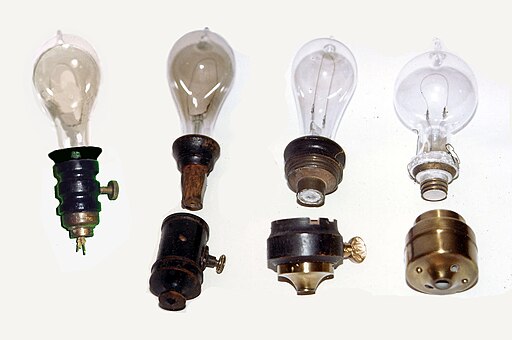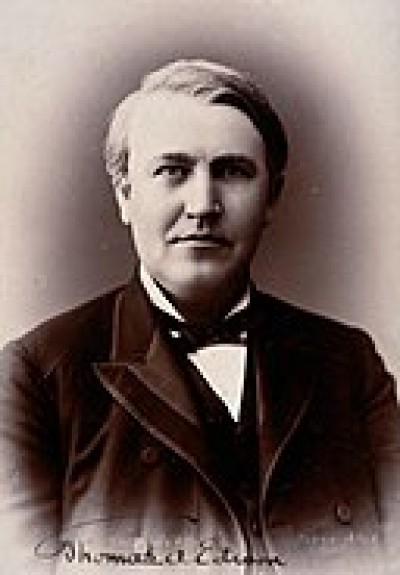Course description
Thomas Edison – The Man who Never Gave Up
 At the age of sixty-seven, Edison watched his life’s work, his huge experimental laboratory at West Orange, New Jersey, burn down. The damage was estimated at seven million dollars in 1914, the year that the fire devastated the laboratories, only two million of which was insured. While watching the flames consume building after building, Edison said to other onlookers that it offered him an opportunity to build more suitable and innovative labs with the most up-to-date equipment.
At the age of sixty-seven, Edison watched his life’s work, his huge experimental laboratory at West Orange, New Jersey, burn down. The damage was estimated at seven million dollars in 1914, the year that the fire devastated the laboratories, only two million of which was insured. While watching the flames consume building after building, Edison said to other onlookers that it offered him an opportunity to build more suitable and innovative labs with the most up-to-date equipment.
But Edison was nothing if not a workaholic. His working days started early in the morning and continued until late at night, only to be followed by parties at the laboratory where the entrepreneurial inventor hosted journalists, politicians and other movers and shakers until the early hours. On one particular evening at just six o’clock, however, Edison told his secretary he was going home. She was aghast! He explained though that he had got married that morning and needed to spend the evening with his new wife. And that response typified his family life: his work always came first – his wife and children had to take a back seat.

Thomas Edison was born in 1847 and attended school for only a few months before his mother schooled him herself, as teachers found it impossible to keep the young man in their classrooms. From an early age, he also sold newspapers on trains, earning $50 a week by the time he was thirteen, most of which he spent on chemistry equipment. He even wrote and printed his own newspaper and sold it on the trains, as it was more profitable than buying and selling national dailies.
Yet, Edison’s fascination with chemistry and experiments did him no favours in those early days. He had managed to get a job as a telegraph operator after learning the skills necessary for the post from a father whose son he had saved from a runaway train. He was sacked though when his negligence – he was busy with a chemistry experiment – nearly caused a head-on collision between two trains. In another unfortunate incident when he was working for Western Union on the night shift, the sulphuric acid he was using in an experiment dripped onto the floor and then fell on his boss’ desk in the room below. He lost that job too.

That is not to say that Edison’s time at Western Union was wasted. He noticed that only a single telegram could be sent at any given time. Ever observant and inventive, the young man designed a system whereby a telegram could be sent and another received simultaneously. He sold this idea and design to Western Union and then, just a few months later, sold the company a different plan for sending four telegrams at the same time. Western Union paid up but also suggested that Edison had known about the more advanced development when he had informed them of the less efficient one less than a year earlier. Edison always had an eye to the most advantageous deal he could get.
It was this same businesslike attitude that dictated his dealings with his own scientific and technical staff. They worked in teams for very long hours but, even though they might originate and develop an idea, their names never appeared on the patents. This might well explain why Edison could manage 1,093 patents in his own name in his lifetime, more than any other American inventor. It also explains why Nikola Tesla left his job with Edison when he felt he had been cheated out of an agreement he believed he had been promised.

Edison’s first laboratory, Menlo Park, was built on the profits of selling the quadruplex telegraph to Western Union. There, the Wizard of Menlo Park devised the first phonograph (or record player), DC electricity supply, the original silent movies, the electric light bulb, the fluoroscope that revolutionized X-rays, batteries, more efficient telephones than Alexander Bell had come up with, and so many more. Yet, once he had patented an invention, Edison often abandoned work on it until he sensed that there was competition in the marketplace. There was simply too much to do, even for his multitude of highly talented scientists and technicians.
Yet, innovation and inventiveness on their own cannot account for Edison’s peculiar financial success. His marketing strategies were not always very scrupulous. Let’s take his war with Westinghouse, a major US company, over electric current as an illustration. Edison had developed Direct Current as a means of supplying homes and industry with electricity. This had some significant drawbacks though: it was very wasteful as much electricity was lost travelling along overhead lines. It could also only be used within a radius of a mile from a power station. This worked well for city dwellers but was useless to those living in the countryside where there were no power stations. Alternating Current (or AC), developed by Tesla for Westinghouse, was not so wasteful and could be delivered to destinations hundreds of miles away.

Whether Edison was sincere in his belief that AC was a disaster waiting to happen, we can never know, but the great man started on a negative publicity campaign about its dangers. First, he took full advantage of a series of accidents involving overhead lines carrying AC electricity, spreading information and misinformation about the risks involved. Next, he used AC himself to electrocute stray dogs that he paid street kids to bring to him. More dramatically, Edison used AC publicly to electrocute a circus elephant that had killed its cruel trainer. Finally, he built an electric chair for New York state to execute criminals sentenced to the death penalty, ensuring that the newspapers published that it was Westinghouse AC supply that killed them – and this despite the fact that he was against the use of capital punishment! In short, Edison’s manipulation of the media in his war against AC supply was, at best, aggressive and vicious and, at worst, outright deceitful.
On the other hand, there was a playful side to Edison that might explain why so many of his employees remained with him for years, even decades, despite the long hours and the lack of public recognition they received for their achievements. In 1920, when he was well into his seventies, he gave an interview to ‘American Magazine’, where he claimed he had invented a telephone with which to communicate with the spirit world. Needless to add, the world’s media was all over the story in a matter of hours. Edison then explained that the journalist clearly expected a scoop and the great inventor did not have the heart to disappoint him!
In fact, Edison did not believe in any god, at least in any god that established religion preached about. He said this on the topic:

“Nature is what we know. We do not know the gods of religions. And nature is not kind, or merciful, or loving. If God made me – the fabled God of the three qualities of which I spoke: mercy, kindness, love – He also made the fish I catch and eat. And where do His mercy, kindness, and love for that fish come in? No; nature made us – nature did it all – not the gods of the religions.”
However, when Edison was accused of atheism, he argued that he had been misunderstood: "I do not believe in the God of the theologians; but that there is a Supreme Intelligence I do not doubt.”
And if we are tempted to consider Edison in an unkind light because of his sharp business practices, it is worth noting that he refused to participate in any research that might lead to weapons of destruction, stating unambiguously that he would only contribute to defense. In his own words: "I am proud of the fact that I never invented weapons to kill." In later life, he also came out against the slaughter of animals for meat and became a vegetarian.
There is no denying that Edison was and remains the most prolific inventor that the USA has ever produced. Any single one of his innovations would guarantee him a well-deserved scientific reputation. But there were so many of them in so many different fields. When he died of diabetes at the age of eighty-four in 1931, he left behind an America that he had done much to transform.
Videos :
1. When Did Thomas Edison Invent The Telegraph (2:31)
2. Difference and comparison between Tesla and Edison (2:56)
3. Thomas Edison story in English (4:04)
4. Thomas Edison – Inventor (2:39)
5. The History of Thomas Edison (3:04)
6. Thomas Edison interviewed at the age of 84 (0:54)
7. Mini Bio - Thomas Edison (2:39)

 At the age of sixty-seven, Edison watched his life’s work, his huge experimental laboratory at West Orange, New Jersey, burn down. The damage was estimated at seven million dollars in 1914, the year that the fire
At the age of sixty-seven, Edison watched his life’s work, his huge experimental laboratory at West Orange, New Jersey, burn down. The damage was estimated at seven million dollars in 1914, the year that the fire 





















